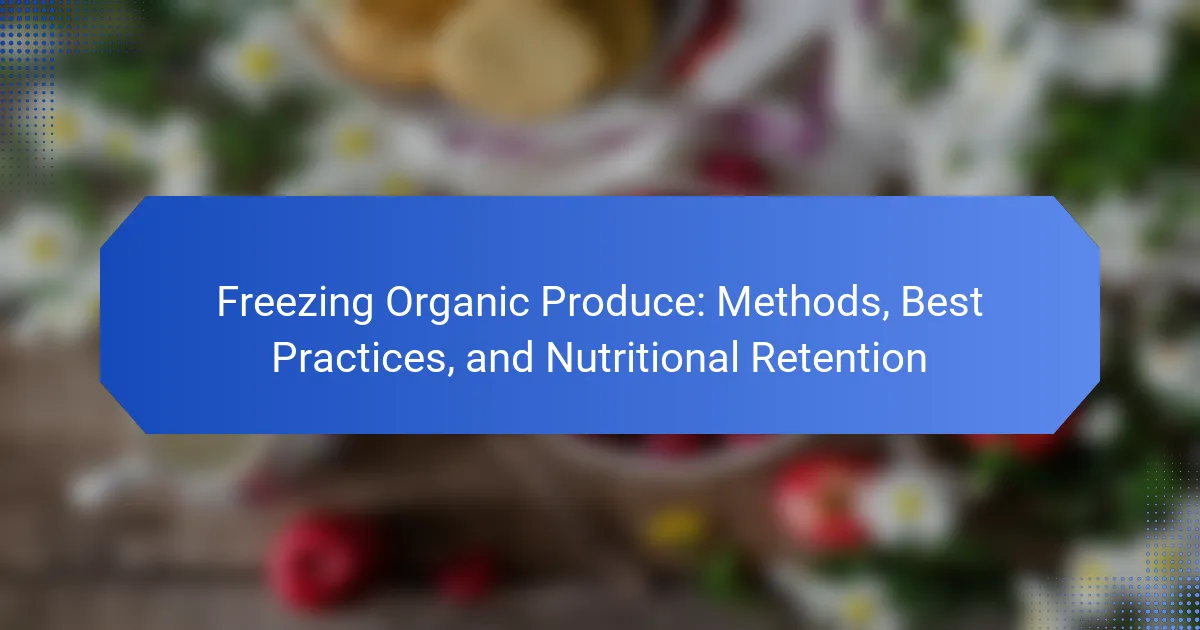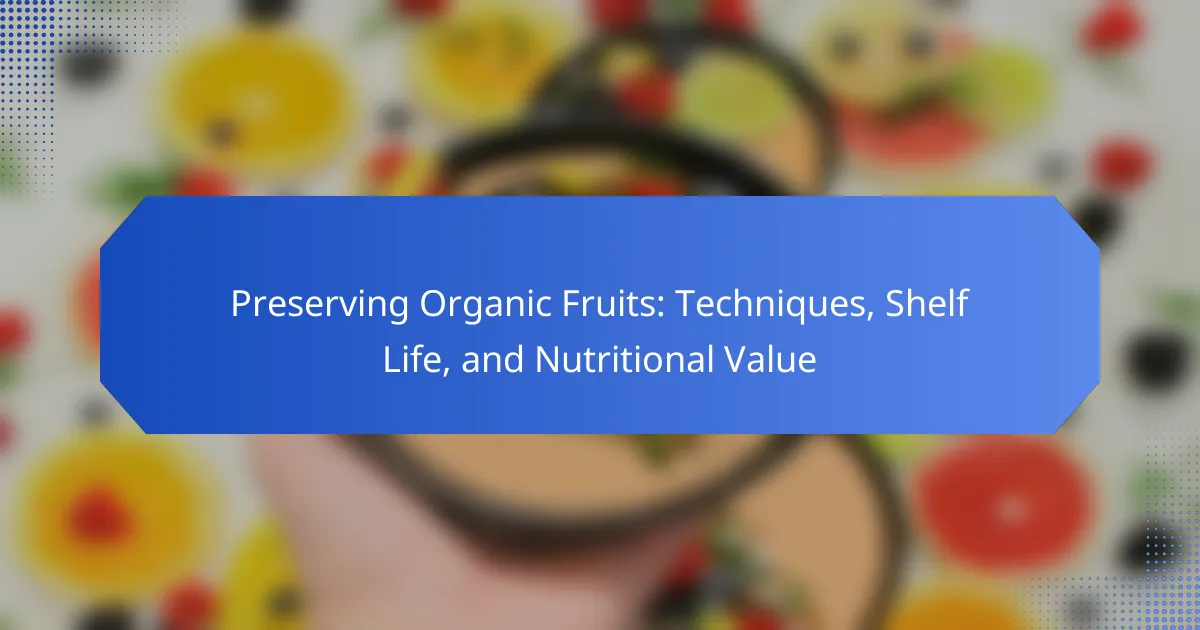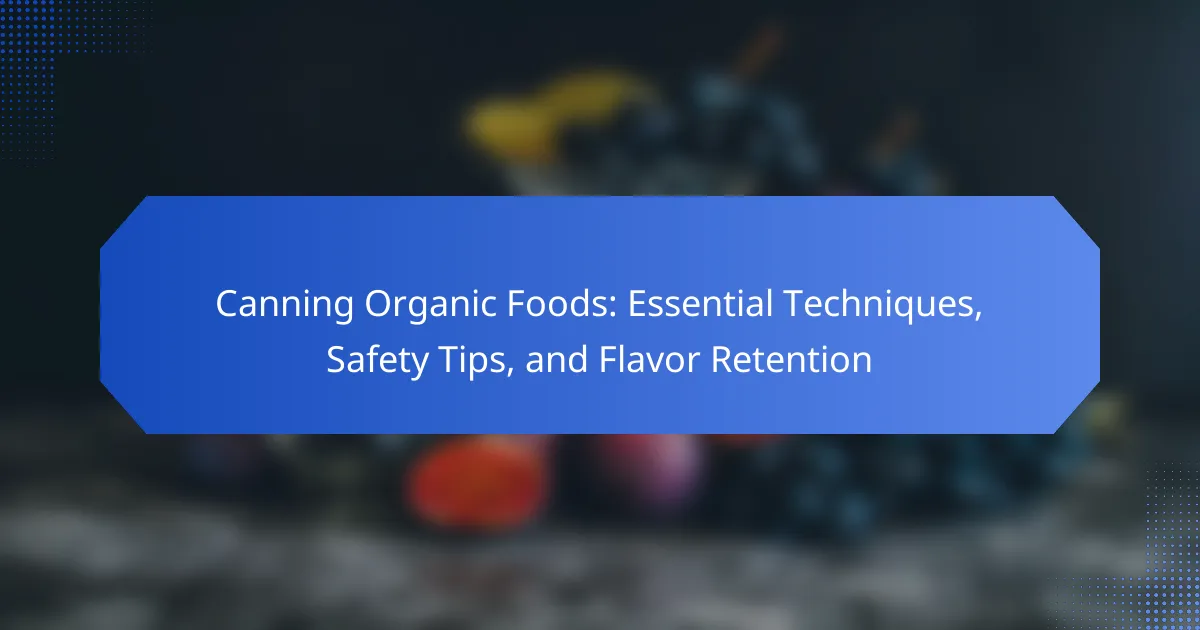Fermenting organic vegetables involves the conversion of sugars in vegetables into acids and gases through beneficial bacteria, enhancing flavor, preservation, and nutritional value. This process primarily relies on lactic acid bacteria, which thrive in anaerobic conditions and produce lactic acid, serving as a natural preservative against harmful bacteria. Common fermented organic vegetables include sauerkraut and kimchi, both known for their potential health benefits, such as improved gut health and immune system support. The fermentation duration varies based on the type of vegetable and desired flavor, typically ranging from several days to weeks. The article will cover the health benefits, methods, and storage guidelines for fermenting organic vegetables.

What is Fermenting Organic Vegetables?
Fermenting organic vegetables is the process of converting sugars in vegetables into acids and gases through the action of beneficial bacteria. This process enhances the vegetables’ flavor, preserves them, and increases their nutritional value. During fermentation, lactic acid bacteria thrive in an anaerobic environment, producing lactic acid as a byproduct. This acid acts as a natural preservative, inhibiting harmful bacteria growth. Common examples of fermented organic vegetables include sauerkraut and kimchi. Studies show that fermented vegetables can improve gut health and boost the immune system. The fermentation process typically takes several days to weeks, depending on the vegetable and desired flavor.
How does the fermentation process work for organic vegetables?
Fermentation of organic vegetables involves the conversion of sugars into acids, gases, or alcohol by microorganisms. This process is primarily facilitated by bacteria, yeasts, and molds. During fermentation, beneficial bacteria such as Lactobacillus consume the natural sugars in the vegetables. As these bacteria metabolize sugars, they produce lactic acid, which acts as a natural preservative.
The acidic environment created by lactic acid inhibits the growth of harmful bacteria. This process not only preserves the vegetables but also enhances their nutritional value. Fermented vegetables often have increased levels of vitamins, particularly B vitamins and vitamin K2. Additionally, the fermentation process can produce probiotics, which are beneficial for gut health.
The process typically begins with the preparation of the vegetables, which are washed and cut. Salt is then added to draw out moisture and create a brine. The vegetables are submerged in this brine to ensure anaerobic conditions, essential for fermentation. Fermentation usually occurs at room temperature and can take several days to weeks, depending on the desired flavor and texture.
Once fermentation is complete, the vegetables can be stored in a cool place to prolong their shelf life. This method not only enhances flavor but also adds health benefits, making fermented organic vegetables a nutritious addition to diets.
What are the key ingredients required for fermenting organic vegetables?
The key ingredients required for fermenting organic vegetables include the vegetables themselves, water, salt, and sometimes additional flavoring agents. Organic vegetables serve as the primary substrate for fermentation. Common vegetables used include cabbage, carrots, and cucumbers. Salt is crucial as it inhibits harmful bacteria while promoting beneficial fermentation microbes. Water is necessary to dissolve the salt and create a brine. Optional flavoring agents can include garlic, spices, or herbs for enhanced taste. The process relies on these ingredients to create an environment conducive to lactic acid bacteria, which ferment the sugars in the vegetables.
What role do microorganisms play in the fermentation of organic vegetables?
Microorganisms are essential for the fermentation of organic vegetables. They break down sugars and starches into acids, gases, and alcohol. This process enhances flavor and preserves the vegetables. Lactic acid bacteria are the primary microorganisms involved. They create an acidic environment that inhibits spoilage organisms. Yeasts and molds can also contribute to fermentation. They add complexity to the flavor profile. The presence of these microorganisms is crucial for achieving the desired taste and texture in fermented products.
What are the health benefits of fermenting organic vegetables?
Fermenting organic vegetables offers numerous health benefits. It enhances the bioavailability of nutrients. Fermentation increases vitamins such as B vitamins and vitamin K. The process also promotes the growth of beneficial probiotics. These probiotics support gut health and improve digestion. Fermented vegetables can boost the immune system. They may help reduce inflammation in the body. Additionally, they can promote better mental health through the gut-brain connection. Studies have shown that fermented foods can improve overall well-being and may reduce the risk of chronic diseases.
How does fermented organic vegetables contribute to gut health?
Fermented organic vegetables contribute to gut health by providing beneficial probiotics. Probiotics are live microorganisms that promote a healthy gut microbiome. They help in digesting food and absorbing nutrients more effectively. Fermented vegetables also enhance the production of short-chain fatty acids, which support gut barrier function. Additionally, they can reduce inflammation in the gut. Studies show that consuming fermented foods can lead to improved digestion and a decrease in gastrointestinal disorders. For example, research published in the journal “Frontiers in Microbiology” highlights the positive impact of probiotics on gut health. This evidence supports the role of fermented organic vegetables in maintaining a healthy digestive system.
What vitamins and nutrients are enhanced through fermentation?
Fermentation enhances several vitamins and nutrients. Key vitamins include B vitamins, such as B12, B6, and folate. Probiotics produced during fermentation also improve nutrient absorption. Minerals like calcium, magnesium, and zinc become more bioavailable. Antioxidants are increased, providing additional health benefits. Fermented foods may also increase the levels of certain amino acids. Research indicates that fermentation can boost the overall nutritional profile of foods. Studies show that fermented vegetables can have higher levels of vitamins compared to their raw counterparts.
What methods can be used for fermenting organic vegetables?
Lacto-fermentation and brine fermentation are popular methods for fermenting organic vegetables. Lacto-fermentation involves using naturally occurring lactic acid bacteria. This method enhances flavor and preserves the vegetables. Brine fermentation requires submerging vegetables in a saltwater solution. The salt draws out moisture and creates an anaerobic environment. Both methods promote beneficial bacteria growth. These bacteria contribute to the development of probiotics. Probiotics are known for their health benefits, including improved digestion. Using these methods, organic vegetables can be preserved for extended periods.
What are the different techniques for fermenting organic vegetables?
The different techniques for fermenting organic vegetables include lacto-fermentation, brining, and dry fermentation. Lacto-fermentation uses lactic acid bacteria to convert sugars into lactic acid. This method enhances flavor and preserves the vegetables. Brining involves submerging vegetables in a saltwater solution, which helps create an anaerobic environment. This technique is effective for pickling. Dry fermentation, also known as dry salting, involves mixing vegetables with salt and allowing them to release their moisture. Each technique promotes beneficial bacteria growth, ensuring successful fermentation.
How can you ensure proper fermentation conditions?
To ensure proper fermentation conditions, maintain a consistent temperature between 65°F and 75°F. This temperature range supports the growth of beneficial bacteria. Monitor the pH level, aiming for a range between 4.2 and 4.6. This acidity inhibits harmful bacteria. Use non-iodized salt at a concentration of 2-3% of the vegetable weight. Salt concentration affects the osmotic balance, promoting fermentation. Ensure vegetables are fully submerged in brine to prevent exposure to air. Air exposure can lead to spoilage. Keep fermentation vessels in a dark, cool place to avoid light exposure. Light can negatively affect the fermentation process. Regularly check for signs of mold or off odors. Early detection can prevent spoilage and ensure a successful fermentation.
How can you store fermented organic vegetables effectively?
Store fermented organic vegetables in airtight containers. Use glass jars or food-grade plastic containers. Ensure the vegetables are fully submerged in their brine. This helps maintain their crunch and flavor. Keep the containers in a cool, dark place. Ideal storage temperatures range from 32°F to 50°F. Refrigeration can extend shelf life. Properly stored, these vegetables can last for several months.
What are the best practices for storing fermented organic vegetables?
Store fermented organic vegetables in a cool, dark place. Ideal storage temperatures range from 32°F to 50°F. Use airtight containers to prevent exposure to air. Glass jars or ceramic crocks are recommended for best results. Ensure that vegetables are fully submerged in the brine to avoid spoilage. Check for signs of fermentation, such as bubbles or sour smell, indicating proper storage. Consume within a few months for optimal flavor and safety. Proper storage methods help maintain the health benefits of fermented vegetables.
How long can fermented organic vegetables be stored without losing quality?
Fermented organic vegetables can be stored for 1 to 6 months without losing quality. The exact duration depends on storage conditions like temperature and light exposure. Typically, refrigeration extends their shelf life significantly. In a cool, dark place, they might last up to 6 months. However, once opened, it’s best to consume them within a few weeks for optimal taste and texture. Quality can diminish over time due to changes in flavor and texture. Monitoring for signs of spoilage is essential.
What common mistakes should be avoided when fermenting organic vegetables?
Common mistakes to avoid when fermenting organic vegetables include not using enough salt. Insufficient salt can lead to spoilage instead of fermentation. Another mistake is not using clean equipment. Contaminated tools can introduce unwanted bacteria. Failing to submerge vegetables completely is also problematic. Vegetables that are not fully submerged may mold. Additionally, neglecting to monitor fermentation temperature can affect results. Ideal temperatures for fermentation range from 60°F to 75°F. Skipping taste tests during fermentation can lead to undesired flavors. Regularly tasting allows for adjustments. Lastly, not allowing enough fermentation time can result in underdeveloped flavors. Proper fermentation can take several days to weeks, depending on the vegetable.
How can improper fermentation affect the final product?
Improper fermentation can lead to undesirable flavors and spoilage in the final product. This occurs when harmful bacteria outcompete beneficial microorganisms. The pH level may not drop sufficiently, allowing pathogens to thrive. Additionally, off-flavors may develop due to the production of undesirable compounds. Textural changes can also occur, resulting in mushy or unappetizing vegetables. Inconsistent fermentation times may lead to uneven results, affecting quality. Research shows that maintaining proper fermentation conditions is crucial for safety and flavor. For instance, a study by the Journal of Food Science highlights the importance of temperature control in achieving optimal fermentation outcomes.
What signs indicate that fermentation has gone wrong?
Signs that indicate fermentation has gone wrong include off-putting odors, unusual colors, and the presence of mold. Off-putting odors may resemble rotten or foul smells, which indicate spoilage. Unusual colors, such as pink or brown hues, suggest that harmful bacteria may be present. The presence of mold, especially on the surface, is a clear indicator of contamination. Additionally, excessive bubbling or fizzing can signal unwanted fermentation activity. A slimy texture on the vegetables may also indicate that fermentation has not proceeded correctly. These signs should prompt immediate disposal of the fermenting product to avoid health risks.
What tips can enhance your experience with fermenting organic vegetables?
Use high-quality, organic vegetables for better fermentation results. Fresh produce contains more nutrients and flavor. Clean vegetables thoroughly to remove dirt and pesticides. This step ensures a healthier fermentation process. Cut vegetables into uniform sizes for even fermentation. Uniform pieces ferment at the same rate, improving consistency. Use non-iodized salt to prevent unwanted reactions. Non-iodized salt aids in the fermentation process without inhibiting beneficial bacteria. Maintain proper temperature during fermentation, ideally between 60°F and 75°F. This range encourages optimal bacterial growth. Taste the fermentation periodically to achieve desired flavor. Regular tasting helps determine the right fermentation duration. Store finished ferments in airtight containers in the refrigerator. This storage method prolongs shelf life and preserves flavor.
Fermenting organic vegetables is the process of converting sugars in vegetables into acids and gases through beneficial bacteria, enhancing flavor, preserving them, and increasing their nutritional value. This article covers the fermentation process, key ingredients, and the role of microorganisms, highlighting health benefits such as improved gut health and increased nutrient bioavailability. It also outlines various fermentation methods, storage guidelines, and common mistakes to avoid, ensuring successful preservation and flavor enhancement of organic vegetables.



